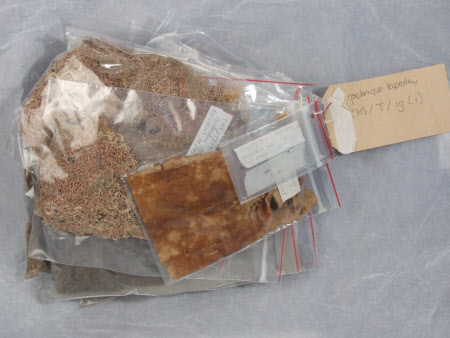Mars and Sol
Oudenaarde
Category
Tapestries
Date
circa 1570 - circa 1590
Materials
Tapestry, wool and silk, 4 warps per cm
Measurements
2.39 m (H); 4.45 m (W)
Place of origin
Oudenaarde
Order this imageCollection
Chastleton House, Oxfordshire
NT 1430619.1
Summary
Tapestry, wool and silk, 4 warps per cm, Mars and Sol from a set of Planetary Gods, Oudenaarde, c. 1570-1590. The main field of the tapestry is filled with grotesque decoration surrounding two central cartouches with figures of the gods Mars and Sol (Apollo). Mars wears armour and carries a shield and a pike, and Sol carries a book and a sceptre, wears a crown and has a sunburst around his head. Above and below the figure of Mars are cartouches with a ram and a scorpion, representing the star signs Aries and Scorpio, while above the figure of Sol is a lion representing the star sign Leo. The surrounding grotesque decoration includes small figures, sea monsters, exotic birds, dog-like creatures with human heads wearing jesters' hats, and a sphinx (in the centre), all arranged among strap work and flowers. The borders of the tapestry are filled with military trophies, weapons and armour. The lower border has at some point been cut off and re-attached.
Full description
The three ‘Planetary Gods’ tapestries in the Sheldon Room at Chastleton represent five of the seven planetary deities, along with their associated zodiac signs. Each figure is set into a background of grotesque decoration with fanciful designs of strap-work, figures and animals on a plain dark green ground. The seven planets known to the ancients and to Renaissance astronomers were Saturn, Venus, Jupiter, Mercury, Mars, Luna (the moon) and Sol (the sun). Luna is also known as the goddess Diana, and Sol as the God Apollo. The identification of the seven visible planets with the gods originated in ancient Greece, as did the association of the planetary gods with the twelve signs of the zodiac. Five of these gods appear in the tapestries at Chastleton: Mars and Sol in one tapestry; Saturn and Jupiter on another, and Luna, or Diana, on a third. The tapestries are probably part of a series that included all seven planetary gods. The surrounding grotesque decoration is different on each tapestry, and contains elements that relate to the god in the centre. For example Mars, the god of war, has warriors either side of him and bundles of weapons to his left, and Saturn, associated with wisdom, has an owl perched on his frame. The borders of the tapestries, decorated with weapons, armour and other military paraphernalia, seem to have little relation to the Planetary Gods and may have been designed for a different tapestry series. It was common for border designs to be re-used, and the military borders of the Chastleton 'Planetary Gods' have been found on tapestries with historical subjects as well. One of the three tapestries, 'Luna', bears a maker’s mark in the form of a small pink heart on the left-hand galloon, which is folded in and therefore not visible from the front of the tapestry. The identity of the maker or entrepreneur who used this signature is unknown. Similar hearts appear on a tapestry of 'Pride and Avarice' mentioned above, and a related tapestry of 'Envy' at Compton Wynyates. Pink hearts are also found on a set of the 'History of Alexander' recently bought by the City of Oudenaarde, and a tapestry of the 'Trojan Horse' in Vianden Castle, Luxemburg. No complete set of ‘Planetary Gods’ tapestries is known to survive. Two tapestries with 'Saturn' and 'Mars' were sold at Christie's, 26 July 1935, the figures identical to those at Chastleton but the designs reversed (Marillier Tapestry Subject Catalogue). The Victoria and Albert Museum has a tapestry with a similar design, and with the same heart-shaped mark found at Chastleton, but the figures in the roundels represent the vices of Pride and Avarice, not the Planetary Gods (Wingfield Digby and Hefford 1980). The three ‘Planetary Gods’ could be among the tapestries that were listed at Chastleton in the posthumous inventory of Walter Jones in 1633, however this is not certain as none of their subjects was named (See Marsden 2000). (Helen Wyld, 2012)
Provenance
Possibly acquired for Chastleton by Walter Jones, before 1633; thence by descent and bequest to Allan Clutton-Brock (1904-1976) and his wife Barbara Foy; acquired by The National Heritage Memorial Fund and transferred to The National Trust in 1991.
Credit line
Chastleton House, The Whitmore-Jones Collection (acquired by The National Heritage Memorial Fund and transferred to The National Trust in 1991).
Marks and inscriptions
Below left hand figure: MARS Below right hand figure: SOL
Makers and roles
Oudenaarde, workshop
References
Marsden, 2000: Jonathan Marsden, “The Chastleton inventory of 1633.” Furniture History 36.2000: pp.23-42. de Meûter et al., 1999: Ingrid de Meûter, Martine Vanwelden et al., Tapisseries d'Audenarde du XVle au XVllle Siècle, Tielt 1999 De Meûter, 1998: Ingrid de Meûter, ‘Flemish Tapestries of the 16th and 17th Centuries in Great Britain and their Connection with Oudenaarde’, Bulletin de liaison du Centre International d’Étude des Textiles Anciens [CIETA], 75 (1998), pp. 97-109 Wingfield Digby and Hefford, 1980: George Wingfield Digby and Wendy Hefford, Victoria and Albert Museum: The Tapestry Collection, Medieval and Renaissance, London 1980 Seznec, 1972: Jean Seznec, The Survival of the Pagan Gods, Princeton 1972 (originally published in French in 1953)

